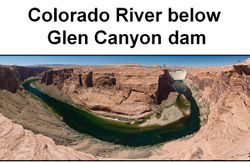Difference between revisions of "GCDAMP Glen Canyon Dam"
From Glen Canyon Dam AMP
(add facts) |
(add http://www.usbr.gov/lc/region/g4000/AOP2014/AOP14_2nd_Consultation_PPT.pdf) |
||
| Line 14: | Line 14: | ||
*Head water snow melt: '''96%''' of Colorado River water comes from above Lake Mead. | *Head water snow melt: '''96%''' of Colorado River water comes from above Lake Mead. | ||
**'''4%''' tributary input from Lake Mead to Mexico. (2013 MSCP CTR meeting- TMurphy) | **'''4%''' tributary input from Lake Mead to Mexico. (2013 MSCP CTR meeting- TMurphy) | ||
| + | ---- | ||
| + | *'''Q''' What is the total release (CFS) possible from Glen Canyon Dam? | ||
| + | **'''A''' [http://www.usbr.gov/lc/region/g4000/AOP2014/AOP14_2nd_Consultation_PPT.pdf Total release during a HFE = '''Capacity + 15,000 cfs bypass'''] | ||
Revision as of 09:46, 30 July 2013
- JAWRA_ Loss Rates from Lake Powell and their impact on management of the Colorado River_Tom Myers_feb 20, 2013
- Estimated that more than 14.8 billion cubic meters has been stored in the banks, with a 90% probablility that the value is actually between 11.8 and 18.5 (Gm 3)
- The Colorado River has 73.4 billion cubic meters of available storage in its 10 largest reservoirs (USBR, 2011), which is approximately four times the river's average annual flow.
- Lake Powell loses water from the river system in two ways: to evaporation from the free water surface and bank seepage.
- Bank Seepage is flow to the banks that does not return to the river system whereas bank storage may return to the reservoir or river system.
- Head water snow melt: 96% of Colorado River water comes from above Lake Mead.
- 4% tributary input from Lake Mead to Mexico. (2013 MSCP CTR meeting- TMurphy)
- Q What is the total release (CFS) possible from Glen Canyon Dam?

